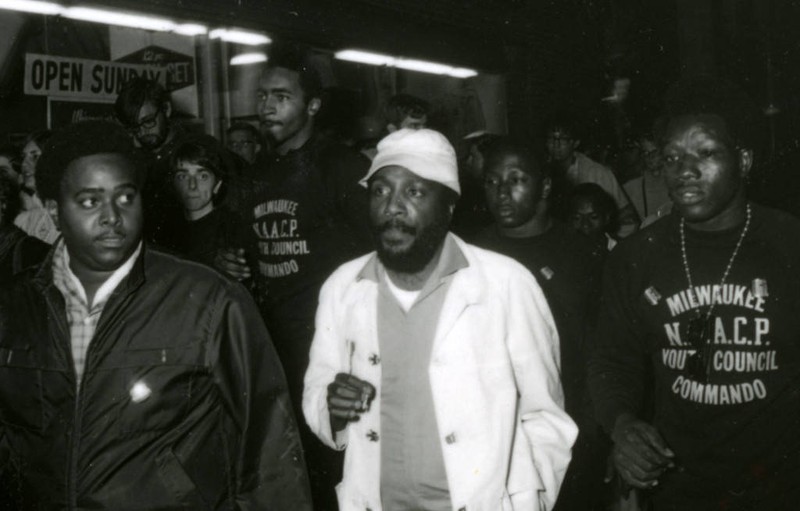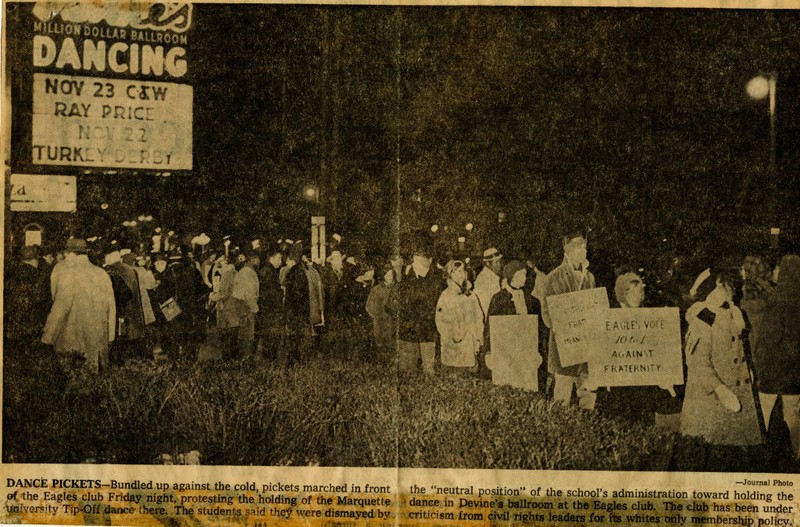Civil Rights Protests, Marquette University
Introduction
Text-to-speech Audio
Images
Students gather in protest outside O'Hara Hall, 1969 (“Department of Special Collections and University Archives, Marquette University Libraries, MUA_014452)

Members of the NAACP Youth Council participate in a march supporting the Milwaukee 14, 1968 (“Department of Special Collections and University Archives, Marquette University Libraries, MUA_013798)

Members of Students United for Racial Equality picket a talk, 1967 (“Department of Special Collections and University Archives, Marquette University Libraries, MUA_011963)

Community members picket the Eagles Club, 1966 (“Department of Special Collections and University Archives, Marquette University Libraries, MUA_013794)

Milwaukee Sentinel report about a student sit-in at O'Hara Hall on April 4, 1968 (“Department of Special Collections and University Archives, Marquette University Libraries, MUA_011958)

Backstory and Context
Text-to-speech Audio
One of the major issues that evoked numerous demonstrations throughout the 1960s and 1970s was that of racial equality and justice. In March 1964 around 700 Marquette students and faculty members gathered outside of Schroeder Hall as they prepared to march with students from UWM to protest in front of the county courthouse to protest the ongoing violence in Selma, Alabama. In 1965 members of the newly formed group Students United for Racial Equality (SURE) organized multiple demonstrations that resulted in the arrest of three students for obstruction of traffic. Early the following year 200 members of SURE and other allied organizations gathered outside the Eagle’s Club building on 24th street and Wisconsin Avenue to protest during the Carnival Dance, while other members attempted a sit-in within the student union. The university had rented a ballroom from the Eagle’s Club, an organization that allowed for ‘”Caucasian-only membership”. SURE’s demonstrations began to heat up by 1968 as they organized a march to O’Hara Hall (11th Street). Among their demands were more scholarships for Black students, more classes on Black culture, and a greater amount of local community outreach programs. Some members even partook in a Lenten fast, consuming only bread, tea, and water for the duration of the fast. Their efforts became even greater following the assassination of Dr. Martin Luther King Jr on April 4th. This sparked an uptick in demonstrations on campus which culminated on May 8th with an incident at the Brooks Memorial Union where 200 students barricaded the doors of the union, trapping over 400 members of the faculty and staff from leaving the Pere Marquette dinner being held inside. When the police arrived to the union, two students were arrested and the barricades were removed. However, later that night 100 demonstrators gathered in the union and refused to leave until the two arrested students were released. Though protests on the issue of racial justice continued into the 1970s and beyond, they never reached the point they had in May of 1968, thanks in part to Father Raynor’s authorization of a special committee that focused on how to alleviate and resolve racial issues.
Sources
Marquette University Special Collections and University Archives
